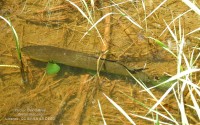Yellow stingray
(Urobatis jamaicensis)

Image source: Jo's Animal Database
Classification
General data
The yellow stingray (Urobatis jamaicensis) is a species of stingray in the family Urotrygonidae, found in the tropical western Atlantic Ocean from North Carolina to Trinidad. This bottom-dwelling species inhabits sandy, muddy, or seagrass bottoms in shallow inshore waters, commonly near coral reefs.
Female yellow stingrays are larger than males. Females reach about a maximum length of about 26 inches whereas the male will reach a maximum legth of about 15 inches across. The yellow stingray has a round pectoral fin disc and a short tail with a well-developed caudal fin. It has a highly variable but distinctive dorsal color pattern consisting of either light-on-dark or dark-on-light reticulations forming spots and blotches, and can rapidly change the tonality of this coloration to improve its camouflage.
Relatively sedentary during the day, the yellow stingray feeds on small invertebrates and bony fishes. When hunting it may undulate its disc to uncover buried prey, or lift the front of its disc to form a cave attractive to shelter-seeking organisms. This species is aplacental viviparous, meaning that the developing embryos are sustained initially by yolk and later by histotroph (uterine milk). Females bear two litters of up to seven young per year in seagrass, following a gestation period of 5–6 months.
Though innocuous towards humans, the yellow stingray can inflict a painful injury with its venomous tail spine.








